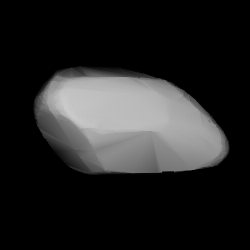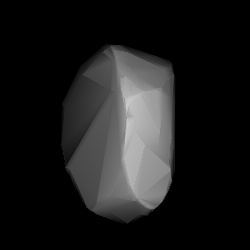Related Research Articles

1743 Schmidt, provisional designation 4109 P-L, is a dark background asteroid from the inner regions of the asteroid belt, approximately 19 kilometers in diameter. It was discovered during the Palomar–Leiden survey on 24 September 1960, by astronomers Ingrid and Cornelis van Houten at Leiden, on photographic plates taken by Tom Gehrels at Palomar Observatory in California. The C-type asteroid has a rotation period of 17.5 hours. It was named for the optician Bernhard Schmidt.
2009 Voloshina, provisional designation 1968 UL, is a carbonaceous asteroid from the outer regions of the asteroid belt, approximately 27 kilometers in diameter.
2730 Barks, provisional designation 1981 QH, is a carbonaceous asteroid from the central regions of the asteroid belt, approximately 15 kilometers in diameter. It was discovered on 30 August 1981, by American astronomer Edward Bowell at Anderson Mesa Station, Arizona, United States. The asteroid was named after comic-book illustrator Carl Barks.
1179 Mally, provisional designation 1931 FD, is an asteroid and long-lost minor planet from the central region of the asteroid belt, approximately 13 kilometers in diameter. Discovered by Max Wolf in 1931, the asteroid was lost until its rediscovery in 1986. The discoverer named it after his daughter-in-law, Mally Wolf.
1027 Aesculapia, provisional designation A923 YO11, is a Themistian asteroid from the outer region of the asteroid belt, approximately 33 kilometers in diameter.
6433 Enya, provisional designation 1978 WC, is a stony background asteroid from the inner regions of the asteroid belt, approximately 7 kilometers in diameter. It was discovered on 18 November 1978, by Czech astronomer Antonín Mrkos at the Kleť Observatory in the Czech Republic. It was named for Irish musician Enya.

9971 Ishihara is a stony Flora asteroid from the inner regions of the asteroid belt, approximately 5 kilometers in diameter. It was discovered by Japanese amateur astronomers Kin Endate and Kazuro Watanabe at Kitami Observatory on 16 April 1993, and named after Takahiro Ishihara, president of the astronomical society at Hiroshima.
2034 Bernoulli, provisional designation 1973 EE, is a stony asteroid from the inner regions of the asteroid belt, approximately 9 kilometers in diameter.
2571 Geisei, provisional designation 1981 UC, is a stony Florian asteroid from the inner regions of the asteroid belt, approximately 6 kilometers in diameter. It was discovered by Japanese astronomer Tsutomu Seki at Geisei Observatory on 23 October 1981, and named for the Japanese village of Geisei.
3640 Gostin, provisional designation 1985 TR3, is a stony Florian asteroid from the inner regions of the asteroid belt, approximately 8 kilometers (5 miles) in diameter. It was discovered on 11 October 1985, by American astronomer couple Carolyn and Eugene Shoemaker at the Palomar Observatory in California. The S-type asteroid has a rotation period of 3.26 hours. It was named for Australian geologist Victor Gostin.
3031 Houston, provisional designation 1984 CX, is a stony Florian asteroid from the inner regions of the asteroid belt, approximately 6 kilometers in diameter. It was discovered on 8 February 1984, by American astronomer Edward Bowell at Anderson Mesa Station near Flagstaff, Arizona. It was named after American amateur astronomer Walter Scott Houston.
4944 Kozlovskij, provisional designation 1987 RP3, is a carbonaceous Witt asteroid from the central regions of the asteroid belt, approximately 10 kilometers (6 miles) in diameter. It was discovered on 2 September 1987, by Soviet astronomer Lyudmila Chernykh at the Crimean Astrophysical Observatory in Nauchnij, on the Crimean Peninsula. The asteroid was named for Russian opera singer Ivan Kozlovsky.
6615 Plutarchos, provisional designation 9512 P-L, is a Florian asteroid and suspected binary from the inner regions of the asteroid belt, approximately 3.1 kilometers in diameter. Discovered during the Palomar–Leiden survey in 1960, the asteroid was later named after the Greek philosopher Plutarch. Its minor-planet moon was discovered in 2007.
4789 Sprattia, provisional designation 1987 UU2, is a stony background asteroid from the inner regions of the asteroid belt, approximately 4 kilometers (2.5 miles) in diameter. It was discovered on 20 October 1987, by Canadian astronomer David Balam at the Climenhaga Observatory (657) in Victoria, Canada. The S-type asteroid has a rotation period of 3.1 hours and was named after Canadian amateur astronomer Christopher E. Spratt.

2111 Tselina is a stony Eos asteroid from the outer regions of the asteroid belt. It was discovered on 13 June 1969, by Soviet astronomer Tamara Smirnova at Crimean Astrophysical Observatory in Nauchnij, on the Crimean peninsula. The S-type asteroid has a rotation period of 6.6 hours and measures approximately 23 kilometers in diameter. It was later named after the Soviet Virgin Lands Campaign.
2011 Veteraniya, provisional designation 1970 QB1, is a stony Vestian asteroid from the inner regions of the asteroid belt, approximately 6 kilometers in diameter. It was discovered on 30 August 1970, by Soviet astronomer Tamara Smirnova at the Crimean Astrophysical Observatory, Nauchnyj, on the Crimean peninsula, and named for the Soviet veterans of the Second World War.
12999 Toruń, provisional designation 1981 QJ2, is a carbonaceous Baptistina asteroid from the inner regions of the asteroid belt, approximately 8 kilometers in diameter. It was discovered on 30 August 1981, by British–American astronomer Edward Bowell at Lowell Observatory's Anderson Mesa Station in Flagstaff, Arizona, and named after the Polish city of Toruń.
40463 Frankkameny (provisional designation 1999 RE44) is a carbonaceous background asteroid from the central region of the asteroid belt, approximately 4 kilometers in diameter. It was discovered on 15 September 1999, by Canadian amateur astronomer Gary Billings at Calgary Observatory (681) in Alberta, Canada. The asteroid was named after American activist Frank Kameny.
12564 Ikeller, provisional designation 1998 SO49, is a stony Koronian asteroid from the outer region of the asteroid belt, approximately 5 kilometers in diameter.
14436 Morishita, provisional designation 1992 FC2, is a stony background asteroid and exceptionally slow rotator from the middle region of the asteroid belt, approximately 5 kilometers in diameter.
References
- 1 2 3 4 5 6 7 "6247 Amanogawa (1990 WY3)". Minor Planet Center. Retrieved 28 May 2018.
- 1 2 3 4 "JPL Small-Body Database Browser: 6247 Amanogawa (1990 WY3)" (2018-04-26 last obs.). Jet Propulsion Laboratory . Retrieved 28 May 2018.
- 1 2 "Asteroid 6247 Amanogawa". Small Bodies Data Ferret. Retrieved 28 May 2018.
- 1 2 3 Masiero, Joseph R.; Mainzer, A. K.; Grav, T.; Bauer, J. M.; Cutri, R. M.; Dailey, J.; et al. (November 2011). "Main Belt Asteroids with WISE/NEOWISE. I. Preliminary Albedos and Diameters". The Astrophysical Journal. 741 (2): 20. arXiv: 1109.4096 . Bibcode:2011ApJ...741...68M. doi:10.1088/0004-637X/741/2/68. S2CID 118745497.
- 1 2 3 4 Mainzer, A.; Grav, T.; Masiero, J.; Hand, E.; Bauer, J.; Tholen, D.; et al. (November 2011). "NEOWISE Studies of Spectrophotometrically Classified Asteroids: Preliminary Results". The Astrophysical Journal. 741 (2): 25. arXiv: 1109.6407 . Bibcode:2011ApJ...741...90M. doi:10.1088/0004-637X/741/2/90. S2CID 118700974. (catalog)
- 1 2 3 4 5 6 7 "LCDB Data for (6247) Amanogawa". Asteroid Lightcurve Database (LCDB). Retrieved 28 May 2018.
- 1 2 3 Waszczak, Adam; Chang, Chan-Kao; Ofek, Eran O.; Laher, Russ; Masci, Frank; Levitan, David; et al. (September 2015). "Asteroid Light Curves from the Palomar Transient Factory Survey: Rotation Periods and Phase Functions from Sparse Photometry". The Astronomical Journal. 150 (3): 35. arXiv: 1504.04041 . Bibcode:2015AJ....150...75W. doi:10.1088/0004-6256/150/3/75. S2CID 8342929.
- 1 2 Carbo, Landy; Kragh, Katherine; Krotz, Jonathan; Meiers, Andrew; Shaffer, Nelson; Torno, Steven; et al. (July 2009). "Asteroid Lightcurve Analysis at the Oakley Southern Sky Observatory and Oakley Observatory: 2008 September and October". The Minor Planet Bulletin. 36 (3): 91–94. Bibcode:2009MPBu...36...91C. ISSN 1052-8091.
- 1 2 Carvano, J. M.; Hasselmann, P. H.; Lazzaro, D.; Mothé-Diniz, T. (February 2010). "SDSS-based taxonomic classification and orbital distribution of main belt asteroids". Astronomy and Astrophysics. 510: 12. Bibcode:2010A&A...510A..43C. doi: 10.1051/0004-6361/200913322 . Retrieved 30 October 2019. (PDS data set)
- ↑ "MPC/MPO/MPS Archive". Minor Planet Center. Retrieved 28 May 2018.